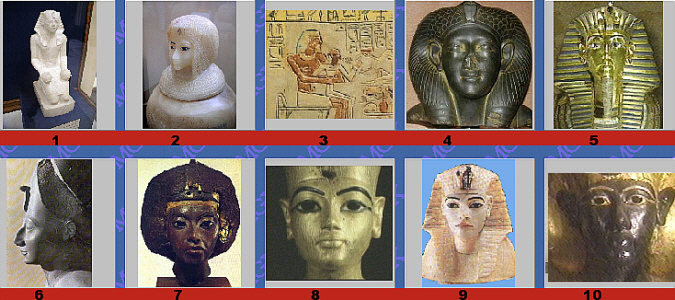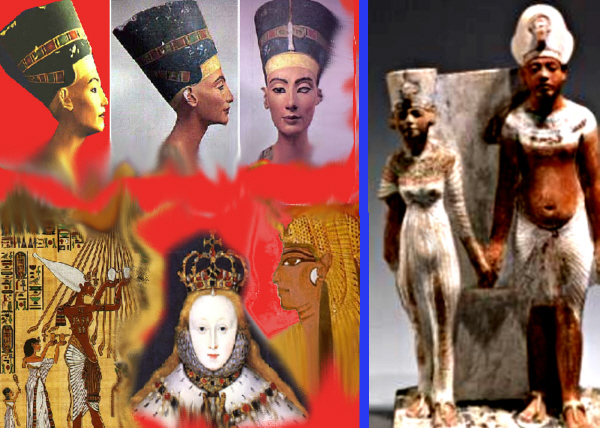
To E-mail this web page
after it is completely loaded
Left click on File
Left click on Send
Left click on Page by E-mail
==================================================
The only way to get an average color of the original Egyptian's faces would
be by
1 Using the same light source color and intensity to photograph all wall
paintings (prefer 6200 k color temperature)
2 Crop out every thing but the faces (exclude eyes, lips, teeth, eyebrows) ...
and use a color temperature meter to average the color of the face. Average
about 1000 faces and you would get an idea what the average Egyptian looked
like.
"Canvas" Here I will use this word when I talk about the material
that is being painted. It may be some clay product in jars, but about all
statues and wall paintings have a stone canvas... they are simply painted on
stone.
#1 The person in image 1 is not ivory white because that is the color of the
statue, the person looks white ONLY because the canvas/material engraved is
white.
#2 The canvas/material for this person is also white, but a few colors were
added to make the eyes have more detail.
#3 There are parts of this picture colored to give detail while other parts
(like the hair) are not painted and again keep the
color of the canvas.
#4 This woman may be black, but only because the canvas/material is black,
does this woman appear black.
#5 This image appears to be engraved in gold. Because the image looks gold,
that is not the actual color of the guy's face, it
is just the color of the canvas/material it is created from.

#6 The color of this guy's face is not actually gray, it is just the color
of the canvas/material the image is made of.
#7 There are both statues and wall paintings of this woman. I don't know what
kind of canvas/material the statue is made of, but in
both statues and wall paintings, this Egyptian is very dark. Some
times the canvas/material is in the ball park of the color of the person, but
most of the time it is not. I can not think of any natural material
with this color brown.
#8, #9 & #10 are said to be images of Tut.
A guy told me the white jar is an image of Tut, but I found a web page which
stated the white jars are not Tut.
The point is #8 yellow, #9 white & #10 dark brown, there are supposed to
be 3 statues of Tut, all a different color.
#8 There is no one with skin this yellow color and yellow lips. There is no
stone material this color, this is not gold, so here it appears it has been
painted yellow (this is not the gold mask of Tut). Unless it is a gold image,
it is yellow paint.
#9 I assumed was a woman when I saw the red lip stick. Then a guy argued it
was an image of Tut (in which a web page stated it is not). The image I saw
was a lone image, not the cluster of 4. I also saw jars they put organs in and
they were only jars with out any image on them.
#10 Is another statue of Tut. It is very dark brown. There are several dark
brown statues and lots of wall paintings. The wall paintings are all of a
brown face, but they are not as dark as the statues.
#10 There is no natural stone (I know of) that is this dark of brown, so it
appears this color paint was used to copy the color of Tut's face.
The points here:
a) Unless the canvas is actually painted a particular shade of human skin
colors ... when there is no paint on that canvas/material, that is not the
color of the actual face of that person.
b) Some times even when a face is painted a color by intent, that may not be
the actual color of that person's face... i.e. pictures of Egyptians with
green faces.
While there may be some Egyptians almost white and others almost black, the
average Egyptian was brown (unlike we Europeans).
***
This picture (on the left side of the blue line) is 5 pictures of Nefertiti
and one of a European queen. I included Nefertiti (1) because she is one of
the lighter Egyptians and (2) by her facial features, she does NOT appear to
be a Negro.
Because she has the lightest skin colors in Egyptians, I compared her with one
of the lightest colors of Europeans.
I have seen other pictures of this European queen that gives her a little more
color than this one. While the darker pictures of this European queen is many
shades lighter than Nefertiti in any of her paintings or statues.
I assume this queen of Europe was very light to begin with and may have added
white powder to her face (or the artist stretched the truth a bit). Egyptians,
too wore make up so this is a variable to consider.
The two pictures (top left) are the very same picture. I just wanted you to
see how skin color can appear different by the kind of lighting used (or maybe
the person on one of these web sites, altered the colors)

On this picture (bottom left) are 3 women. One of them supposed to be
Nefertiti. Note how much darker brown she is in the wall painting than in the
famous statue.
To the right of the white European queen is supposed to be another picture of
Nefertiti, again much darker than the statue at the top.
On the right side of the blue line ... This is a painted
limestone statuette of Akhenaton, ruler of Egypt during the Amarna
period, and his wife, Nefertiti.
© 1993-2003 Microsoft Corporation. All rights reserved.
Of the numerous paintings and statues of Nefertiti, only one makes her
almost "white" while all the rest displays her as being medium to
dark brown.
NOTE the statue to the right of the blue line is painted
on limestone. That means the artist had to
purposely used this color of brown to paint her face.
Point, you can not just find one picture and say this is what the ancient
Egyptians looked like. Not only do you have the different artist
"interpretations", what kind of paint did each have available, what
are the possible color changes caused by the elements, what was the lighting
source and type film when these pictures were taken of the painting ... there
are many variables.
Back to the Oasis
zendz